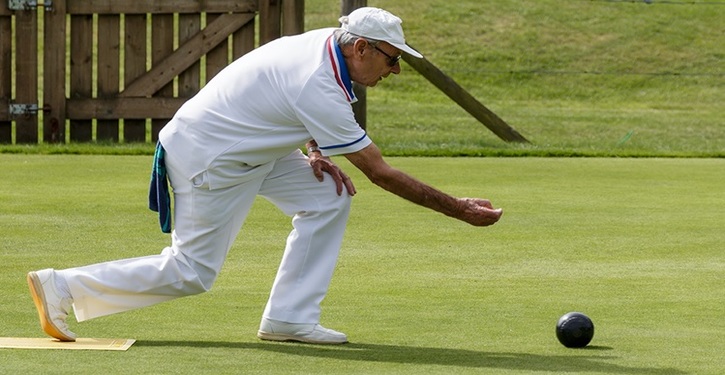Credibility is a big word in sport. Well into the second half of our sporting careers, we are all tempted to exaggerate (ever-so-slightly) the magnitude of our earlier achievements. The trial with Brentford, the county badminton career, the 1500m time that Seb Coe would have been happy with. There’s no way of checking all these claims, but people nod sagely when confronted by them, while silently mouthing ‘respect.’
Tackling the stigma surrounding ‘walking sports’
Until you know better, that’s one of the first problems with walking sport: credibility. Tell someone that you play walking football and they sigh sympathetically. Poor old you. Knees gone and barely able to get the heart rate above 60. Never mind. At least you’re doing something.
Well, it’s time to crush the credibility misconception with one almighty sledgehammer. The word ‘walking’ sounds tame, but it can roar like a lion if it wants to. Consider walking sports a revamped, walking version of the running games we all know in love in a safe, social and inclusive environment – without compromising on energy or competition. It can be as exhausting as you want it to be! From walking football to walking netball and walking rugby, there’s a whole range of sports at your fingertips (and feet!).
Powering your physical and mental health
All the walking team sports have, at their heart, a stop-start format. You stand still. You walk. You walk faster. You stop. You turn. And off you go again. That’s the basis for being an international athlete, albeit at a slightly quicker pace. You really can work up a sweat playing walking sports. Not to mention the psychological benefits. Physical activity boosts mental wellbeing – just 10 minutes of brisk walking increases mental alertness, energy and mood. Participating in regular physical activity improves self-esteem, while reducing stress and anxiety. So, don’t allow the cynics to dismiss walking sports as ‘a walk in the park’ – it’s so much more than that. Have a go and you’ll genuinely feel a difference.
Walk this way – rules are made to be broken, aren’t they?
OK, maybe that’s a little flippant, but I wanted to clear up any confusion about the rules of walking sport. Firstly, don’t be put off by a lack of knowledge of the game, or new rules to accommodate the walking aspect – it really is quite simple. Take walking football, for example. Dribbling, passing and scoring remain important elements of the game and you’ll still feel like you’ve exerted energy.
Secondly, whilst there’s official rules by the national bodies, each sport or social group may have its own rules. However, these are flexible and can change to suit players’ needs. The two most important rules: walk (sounds silly, but it’s easy to forget in the moment. Always keep one foot in contact with the floor) and, secondly, have fun!
Let’s focus on the popular rules that differentiate walking sports from their running versions. If you fancy getting involved, pop along to a session to hear how your local club or leisure centre plays. You may hear the following or why not be proactive and make suggestions? You could introduce a fun new rule to up the ante, because who doesn’t love a challenge? Or if you’re new to the game, don’t worry – the inspiring coaches and supportive teammates will show you the way.
Walking football:
- Many teams adopt a ‘no offside rule’ approach (sighs of relief all round!)
- Some groups play ‘no contact’ – while low impact contact suits those feeling more competitive
- Why not try Touch Football to even the playing field and ensure the Cristiano Ronaldos of the team aren’t the only ones having all the fun?
Walking basketball:
- To increase your chances of scoring (and winning) introduce a longer violation rule. Many walking basketball teams offer 30 seconds to shoot once a player has the ball (instead of 24 seconds, as per standard basketball)
Walking hockey:
- In many games, the ball stays below knee height, with the stick below waist height at all times
- Suggest pushing the ball, rather than hitting it hard to reduce the chance of injury
- An extra safety measure is ‘no contact’
- If the ball is accidentally raised, let it drop to the pitch before it can be played. Keep a close eye on anyone who may be too eager!
Walking netball:
- A ‘no jumping’ rule makes for a fun challenge – especially when you want to score
- Why not try this? A player receives the ball with one foot grounded, and then can take two steps only in possession of the ball before throwing or shooting. This keeps the momentum going but also, from a safety perspective, reduces the impact on landing
- A challenge to your Goal Shooter and Goal Attack players – once you catch the ball outside the goal circle, you’re not allowed to use your consecutive steps to enter the goal circle and shoot. A little extra work for the team that keeps the game exciting!
Walking rugby:
- Play touch rugby style – no contact (apart from a steal), so you needn’t worry about those high tackles! Many walking sports teams suggest that two hands on shorts is all the contact made, which qualifies as a tackle
- For a twist on traditional rugby, try not to throw the ball above head height
- Rather than bend for a try, suggest players walk across the try line, ball in hand
- Some teams suggest a scrum with a maximum of three players per team in upright standing positions
Consider any rule changes all part of the fun – you’re adapting what you might have always known to a new environment. Walking sports is all about opportunity, not obstacles.
At all the walking sports events I’ve attended, one word keeps re-entering my vocabulary: respect. Players respect you if you’re there to take part just for the fun and contribute to the group in your own positive way – whether that’s making people laugh or offering encouragement. As time goes on, more and more people will understand the concept and the value of walking sport. There really is no crisis of credibility.

